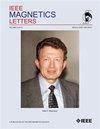Method to Suppress Polar Kerr Signal in a Longitudinal Magneto-Optic Kerr Effect Measurement
IF 1.1
4区 物理与天体物理
Q4 ENGINEERING, ELECTRICAL & ELECTRONIC
引用次数: 0
Abstract
The magneto-optical Kerr effect (MOKE) is a convenient technique to study the magnetization of thin films. However, both polar and longitudinal MOKE responses contribute to the total Kerr response in a typical longitudinal MOKE measurement. Here, we present a simple optical technique to suppress the polar MOKE response in the oblique angle incidence by exploiting differences between polar and longitudinal MOKE responses upon double reflection from the sample. By using a mirror to reflect the beam and by selectively using a quarter-wave plate, the polar or longitudinal MOKE signals can be suppressed and, therefore, studied separately using the same oblique experimental setup. To demonstrate the feasibility of this technique, we use an out-of-plane magnetized Pt/Co/Pt film and a Pt/Co/Cu/NiFe heterostructure with both in-plane and out-of-plane magnetization. We show that the polar MOKE of the CoPt film can be suppressed by a factor of 6 compared to a conventional MOKE measurement. By accounting for birefringence, we further reduce the polar MOKE response in a longitudinal MOKE measurement of the Pt/Co/Cu/NiFe film by over 160 times compared to a conventional oblique-angle MOKE measurement.纵向磁光克尔效应测量中抑制极性克尔信号的方法
磁光克尔效应(MOKE)是研究薄膜磁化特性的一种方便的方法。然而,在典型的纵向MOKE测量中,极性和纵向MOKE响应都对总Kerr响应有贡献。在这里,我们提出了一种简单的光学技术,通过利用样品双反射时的极性和纵向MOKE响应之间的差异来抑制斜角度入射下的极性MOKE响应。通过使用镜面反射光束和选择性地使用四分之一波片,可以抑制极性或纵向MOKE信号,因此可以使用相同的斜向实验装置分别研究。为了证明该技术的可行性,我们使用了面外磁化Pt/Co/Pt薄膜和具有面内和面外磁化的Pt/Co/Cu/NiFe异质结构。我们表明,与传统的MOKE测量相比,CoPt薄膜的极性MOKE可以被抑制6倍。通过考虑双折射,我们进一步降低了Pt/Co/Cu/NiFe薄膜纵向MOKE测量的极性MOKE响应,比传统的斜角度MOKE测量降低了160倍以上。
本文章由计算机程序翻译,如有差异,请以英文原文为准。
求助全文
约1分钟内获得全文
求助全文
来源期刊

IEEE Magnetics Letters
PHYSICS, APPLIED-
CiteScore
2.40
自引率
0.00%
发文量
37
期刊介绍:
IEEE Magnetics Letters is a peer-reviewed, archival journal covering the physics and engineering of magnetism, magnetic materials, applied magnetics, design and application of magnetic devices, bio-magnetics, magneto-electronics, and spin electronics. IEEE Magnetics Letters publishes short, scholarly articles of substantial current interest.
IEEE Magnetics Letters is a hybrid Open Access (OA) journal. For a fee, authors have the option making their articles freely available to all, including non-subscribers. OA articles are identified as Open Access.
 求助内容:
求助内容: 应助结果提醒方式:
应助结果提醒方式:


